Abstract
Antibodies against Trichomonas vaginalis were detected in serum samples from 98 patients by three immunological assays. A good correlation was observed between the enzyme-linked immunosorbent assay and the immunofluorescence method, whereas it was found that the enzyme-linked immunosorbent assay correlated better with the current or past detection of organisms than did other serological methods (immunofluorescence and hemagglutination). Similar results were obtained with whole trichomonads and two T. vaginalis soluble antigenic preparations, which suggests that immunodominant moieties shared by several T. vaginalis strains were detected. The level of antibodies of the immunoglobulin A class was higher in patients with past records of trichomoniasis, but less significantly so than the total antitrichomonal antibody level. Antibodies of the four immunoglobulin G subclasses were detected. Immunoglobulin G1 antibody values were higher in female than male patients.
Full text
PDF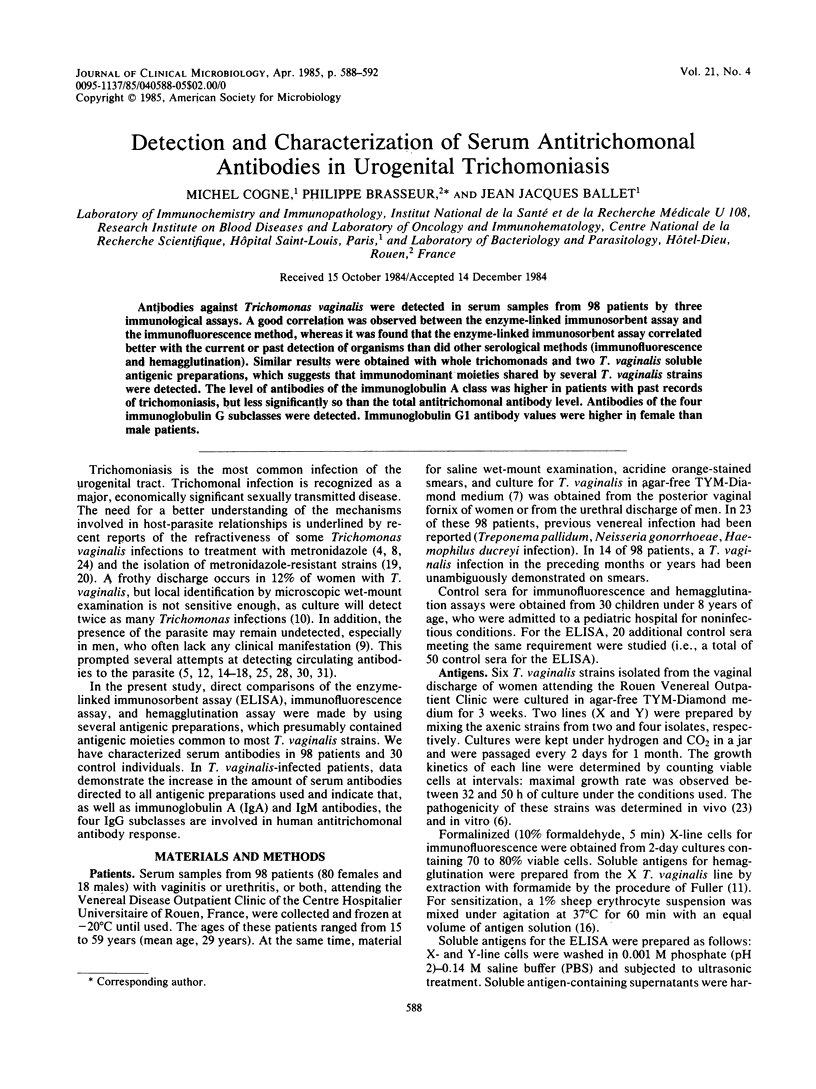
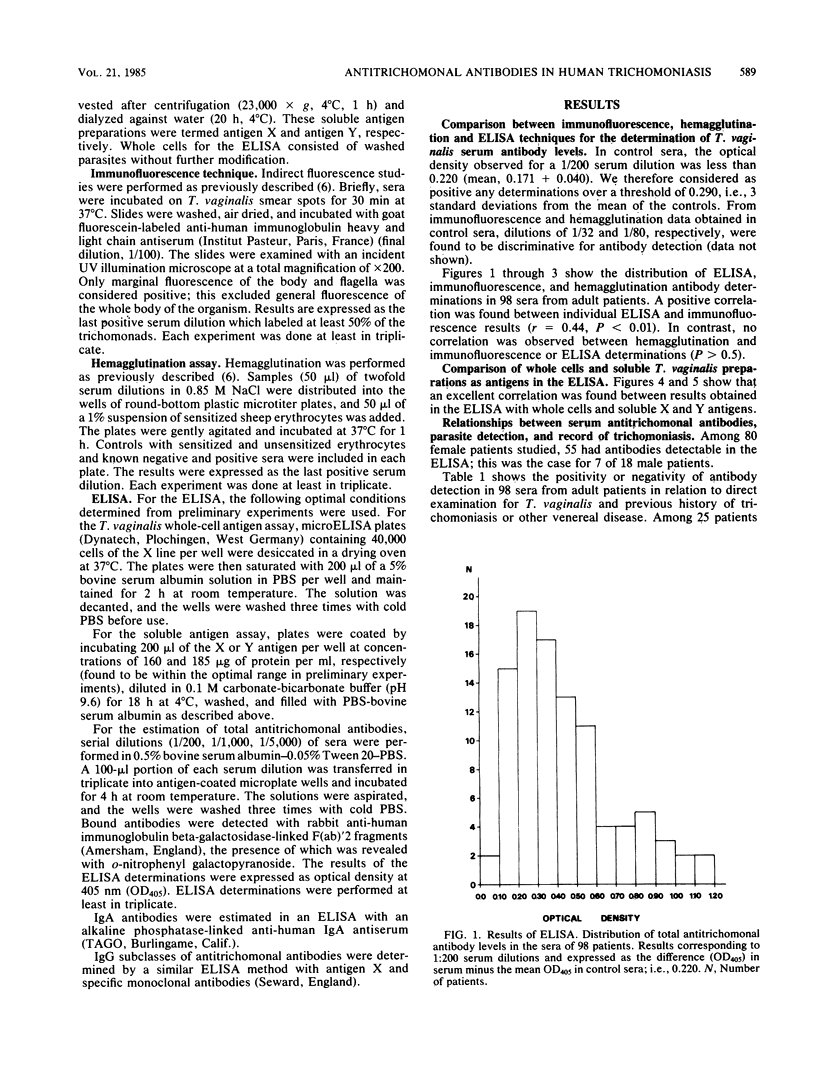
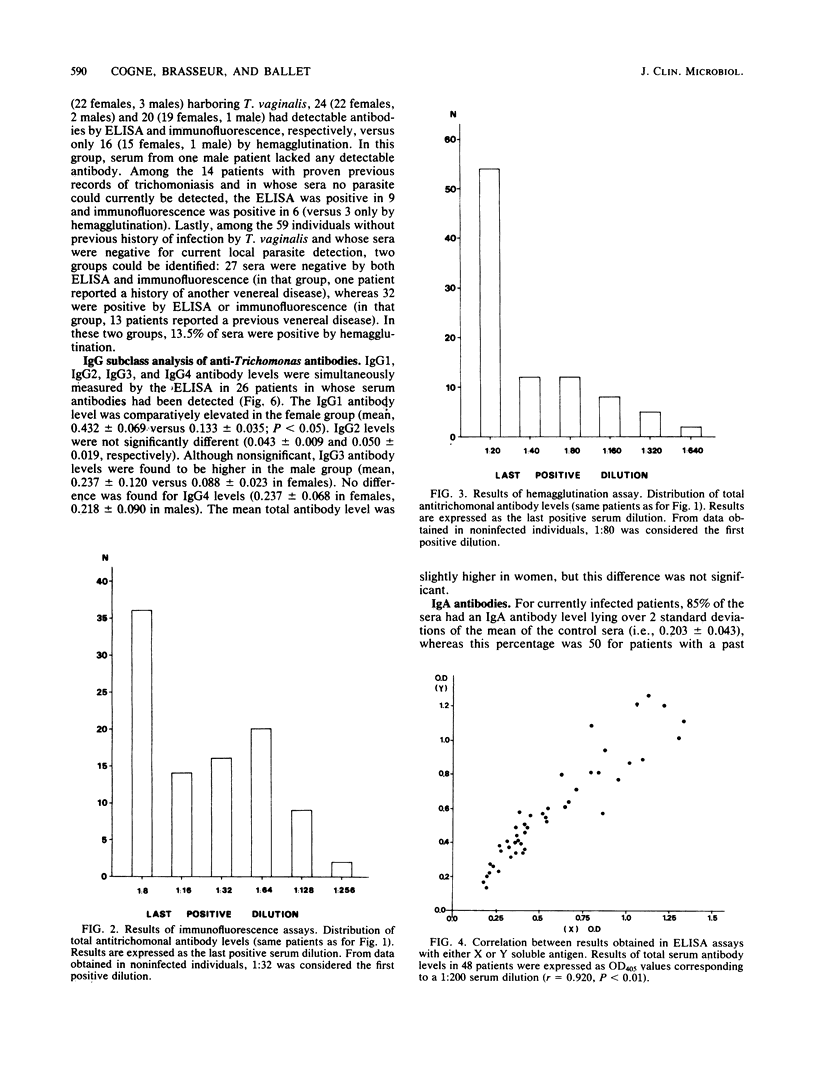
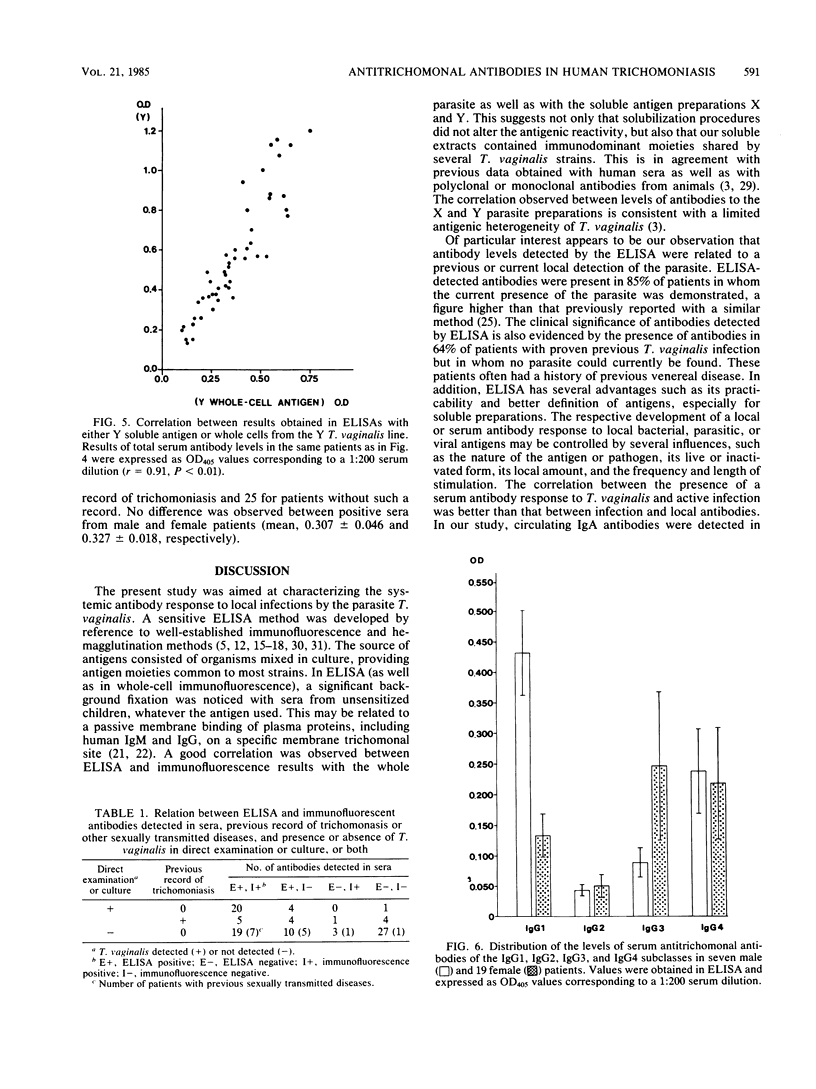
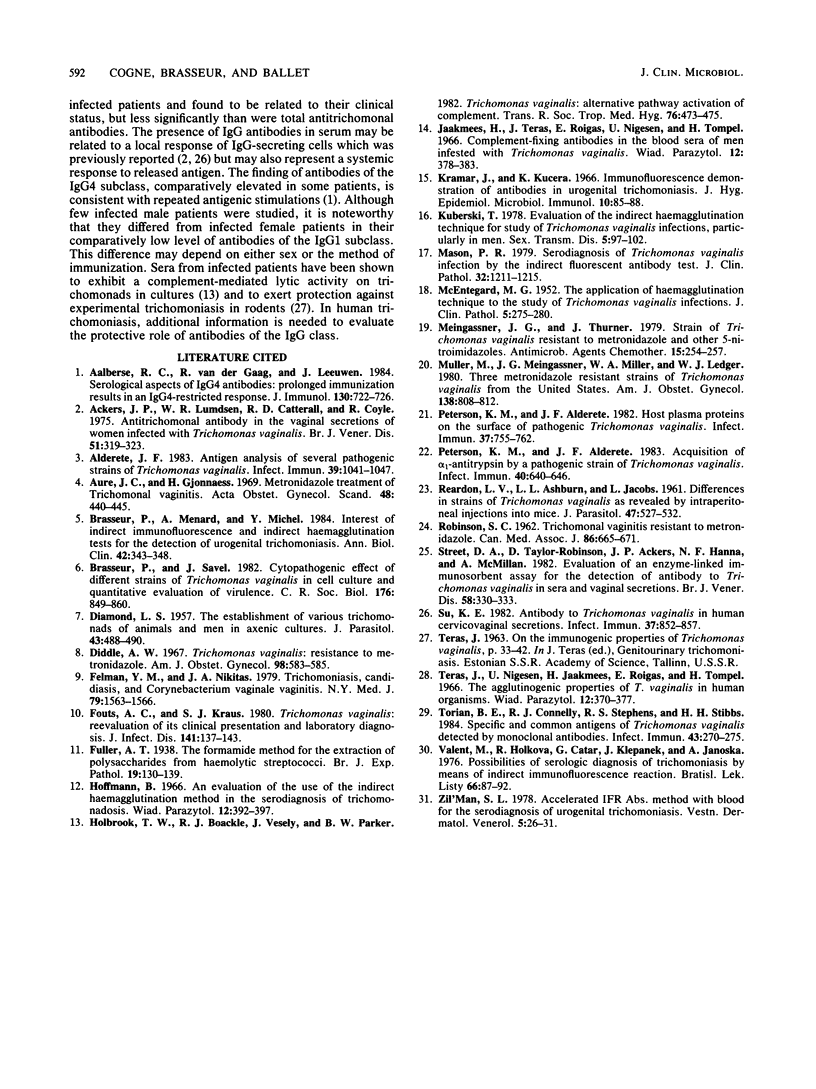
Selected References
These references are in PubMed. This may not be the complete list of references from this article.
- Aalberse R. C., van der Gaag R., van Leeuwen J. Serologic aspects of IgG4 antibodies. I. Prolonged immunization results in an IgG4-restricted response. J Immunol. 1983 Feb;130(2):722–726. [PubMed] [Google Scholar]
- Ackers J. P., Lumsden W. H., Catterall R. D., Coyle R. Antitrichomonal antibody in the vaginal secretions of women infected with T. vaginalis. Br J Vener Dis. 1975 Oct;51(5):319–323. doi: 10.1136/sti.51.5.319. [DOI] [PMC free article] [PubMed] [Google Scholar]
- Alderete J. F. Antigen analysis of several pathogenic strains of Trichomonas vaginalis. Infect Immun. 1983 Mar;39(3):1041–1047. doi: 10.1128/iai.39.3.1041-1047.1983. [DOI] [PMC free article] [PubMed] [Google Scholar]
- Aure J. C., Gjonnaess H. Metronidazole treatment of trichomonal vaginitis. A comparison of cure rates in 1961 and 1967. Acta Obstet Gynecol Scand. 1969;48(3):440–445. doi: 10.3109/00016346909156659. [DOI] [PubMed] [Google Scholar]
- Brasseur P., Menard A., Michel Y. Intérêt des réactions d'immunofluorescence indirecte et d'hémagglutination passive pour le dépistage de la trichomonase urogénitale. Ann Biol Clin (Paris) 1984;42(5):343–348. [PubMed] [Google Scholar]
- Brasseur P., Savel J. Evaluation de la virulence des souches de Trichomonas vaginalis par l'étude de l'effet cytopathogène sur culture de cellules. C R Seances Soc Biol Fil. 1982;176(6):849–860. [PubMed] [Google Scholar]
- DIAMOND L. S. The establishment of various trichomonads of animals and man in axenic cultures. J Parasitol. 1957 Aug;43(4):488–490. [PubMed] [Google Scholar]
- Diddle A. W. Trichomonas vaginalis: resistance to metronidazole. Am J Obstet Gynecol. 1967 Jun 15;98(4):583–585. doi: 10.1016/0002-9378(67)90118-4. [DOI] [PubMed] [Google Scholar]
- Felman Y. M., Nikitas J. A. Trichomoniasis, candidiasis, and Corynebacterium vaginale vaginitis. N Y State J Med. 1979 Sep;79(10):1563–1566. [PubMed] [Google Scholar]
- Fouts A. C., Kraus S. J. Trichomonas vaginalis: reevaluation of its clinical presentation and laboratory diagnosis. J Infect Dis. 1980 Feb;141(2):137–143. doi: 10.1093/infdis/141.2.137. [DOI] [PubMed] [Google Scholar]
- Holbrook T. W., Boackle R. J., Vesely J., Parker B. W. Trichomonas vaginalis: alternative pathway activation of complement. Trans R Soc Trop Med Hyg. 1982;76(4):473–475. doi: 10.1016/0035-9203(82)90140-7. [DOI] [PubMed] [Google Scholar]
- Kramár J., Kucera K. Immunofluorescence demonstration of antibodies in urogenital trichomoniasis. J Hyg Epidemiol Microbiol Immunol. 1966;10(1):85–88. [PubMed] [Google Scholar]
- Kuberski T. Evaluation of the indirect hemagglutination technique for study of Trichomonas vaginalis infections, particularly in men. Sex Transm Dis. 1978 Jul-Sep;5(3):97–102. doi: 10.1097/00007435-197807000-00004. [DOI] [PubMed] [Google Scholar]
- Mason P. R. Serodiagnosis of Trichomonas vaginalis infection by the indirect fluorescent antibody test. J Clin Pathol. 1979 Dec;32(12):1211–1215. doi: 10.1136/jcp.32.12.1211. [DOI] [PMC free article] [PubMed] [Google Scholar]
- McENTEGART M. G. The application of a haemagglutination technique to the study of Trichomonas vaginalis infections. J Clin Pathol. 1952 Aug;5(3):275–280. doi: 10.1136/jcp.5.3.275. [DOI] [PMC free article] [PubMed] [Google Scholar]
- Meingassner J. G., Thurner J. Strain of Trichomonas vaginalis resistant to metronidazole and other 5-nitroimidazoles. Antimicrob Agents Chemother. 1979 Feb;15(2):254–257. doi: 10.1128/aac.15.2.254. [DOI] [PMC free article] [PubMed] [Google Scholar]
- Müller M., Meingassner J. G., Miller W. A., Ledger W. J. Three metronidazole-resistant strains of Trichomonas vaginalis from the United States. Am J Obstet Gynecol. 1980 Dec 1;138(7 Pt 1):808–812. doi: 10.1016/s0002-9378(16)32741-7. [DOI] [PubMed] [Google Scholar]
- Peterson K. M., Alderete J. F. Acquisition of alpha 1-Antitrypsin by a pathogenic strain of Trichomonas vaginalis. Infect Immun. 1983 May;40(2):640–646. doi: 10.1128/iai.40.2.640-646.1983. [DOI] [PMC free article] [PubMed] [Google Scholar]
- Peterson K. M., Alderete J. F. Host plasma proteins on the surface of pathogenic Trichomonas vaginalis. Infect Immun. 1982 Aug;37(2):755–762. doi: 10.1128/iai.37.2.755-762.1982. [DOI] [PMC free article] [PubMed] [Google Scholar]
- REARDON L. V., ASHBURN L. L., JACOBS L. Differences in strains of Trichomonas vaginalis as revealed by intraperitoneal injections into mice. J Parasitol. 1961 Aug;47:527–532. [PubMed] [Google Scholar]
- Robinson S. C. Trichomonal Vaginitis Resistant to Metranidazole. Can Med Assoc J. 1962 Apr 7;86(14):665–665. [PMC free article] [PubMed] [Google Scholar]
- Street D. A., Taylor-Robinson D., Ackers J. P., Hanna N. F., McMillan A. Evaluation of an enzyme-linked immunosorbent assay for the detection of antibody to Trichomonas vaginalis in sera and vaginal secretions. Br J Vener Dis. 1982 Oct;58(5):330–333. doi: 10.1136/sti.58.5.330. [DOI] [PMC free article] [PubMed] [Google Scholar]
- Su K. E. Antibody to Trichomonas vaginalis in human cervicovaginal secretions. Infect Immun. 1982 Sep;37(3):852–857. doi: 10.1128/iai.37.3.852-857.1982. [DOI] [PMC free article] [PubMed] [Google Scholar]
- Torian B. E., Connelly R. J., Stephens R. S., Stibbs H. H. Specific and common antigens of Trichomonas vaginalis detected by monoclonal antibodies. Infect Immun. 1984 Jan;43(1):270–275. doi: 10.1128/iai.43.1.270-275.1984. [DOI] [PMC free article] [PubMed] [Google Scholar]
- Valent M., Holková R., Catár G., Klepanec J., Jánoska A. Moznosti sérologickej diagnostiky trichomoniázy pomocou nepriamej imunofluorescencnej reakcie. Bratisl Lek Listy. 1976 Jul 1;66(1):87–92. [PubMed] [Google Scholar]


